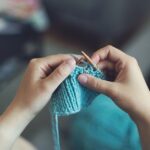If you have ever chosen a new knitting project and thought why your piece pattern does not look like anything, then the answer can be your needle size. Many niers – especially when starting—underestimate how much impact the size of your needles can be on your work.
From the stiffness of its stitches to the overall drape of the fabric, the size of the needle plays a role in the result of every project. Let’s break the sizes of the needles for weaving and why they really matter.
Why Knitting Needle Shape Matters
The size of your needles directly affects Gauge – It is how many stitches and rows you get per inch or centimeter. Using a larger needle than recommended will give you a relaxed, more open dresses, while a small needle will create a tight, denseness one.
Why is this thing? Well, gauge is important when you are weaving something that needs to be fitted properly, such as jumper or bean. Even a small difference in gauge can give rise to a finished product that is very tight, very baggie, or just plain misin. The needle size also changes Faculture And Hanging From your pieces – something you want to control if you are working with special yarn or delicate designs. here are some Handy weaving add-on,
Choosing The Right Size For Your Yarn
The weight of each yarn has a recommended needle shape range, and they are usually printed correctly on the label. For example:
- Lace Weight Yarn: 1.5 mm – 2.25 mm
- DK (Double Weave): 3.75 mm – 4.5 mm
- Chunky Yarn: 6 mm – 8 mm
These are not strict rules, however—think more as guidelines. If you want a relaxed, flowered fabric (ask for summer shawls), you can choose a larger needle than the label. On the other hand, if you want a strict stitch for the structure (eg for toys or homeware), you can go small.
Always keep in mind your yarn and project type when choosing the size of the needle—and do not be afraid to use.
Needle Size Matching For Project Types
Some projects work better with just specific needle shapes. Here is a quick breakdown:
- Scarf and dishes: Often made with the worst or chunky yarn, so a 4.5 mm–6 mm needle works well.
- Hats and socks: Usually use fine yarn and small needles (2 mm – 4 mm) for a snug fit.
- Jumpers and Cardigan: 3.75 mm – DK or Aran yarn and Neei are common in 5 mm range.
- Chunky blanket: Big yarn calls for big needles—sometimes 10 mm or more.
The shape is correct; it helps to make your project comfortable, wearable and visually attractive. If you are uncertain, check the pattern—you usually need to match the exact needle shape and gauge.
Equipment To Help Take The Right Shape
When you are choosing the size of your needle or double-checked, some simple tools can make all the difference. There are some here:
- Needle gauge: Easy small cards with holes that help you identify the size of unavailable or worn needles.
- Gauge ruler: Used to measure your swatch and check if your stitching matches the pattern.
- Voluntary: Yes, it takes time, but a quick sample swatch weaving is the best way to see if your needle size is giving you the right gauge and fabric experience.
- Weaving apps: There are some great ones that include size converters, stash organizers, and pattern support.
By taking a few extra minutes to measure, you can save hours of frogging later.
General Mistakes And How To Avoid Them
Even experienced knives can fall into these nets:
- Ignore the recommended size of the pattern: Even if you think your stress is present, always check your gauge.
- Mixing UK and US sizes: Re-check your needles—a US 10 is not the same as UK 10.
- Suppose all brands are the same: Different needle brands may have slight changes in size or length, even if the diameter is technically the same.
- Swap the mid-project to the needles: If you change to a separate brand or type of needle, your stress can also change.
To avoid these mistakes, being consistent, check your equipment, and know how to adjust if something is felt.
Conclusion
The needle size may look like a small detail, but it is one of the most important options you make in any weaving project. From shaping your stitches to controlling the overall experience of the fabric, the right-sized needle brings your creative vision to life.
So the next time you cast, take a moment to think about your needles—and maybe weave a quick switch. Your future (and your finished project) will thank you.







